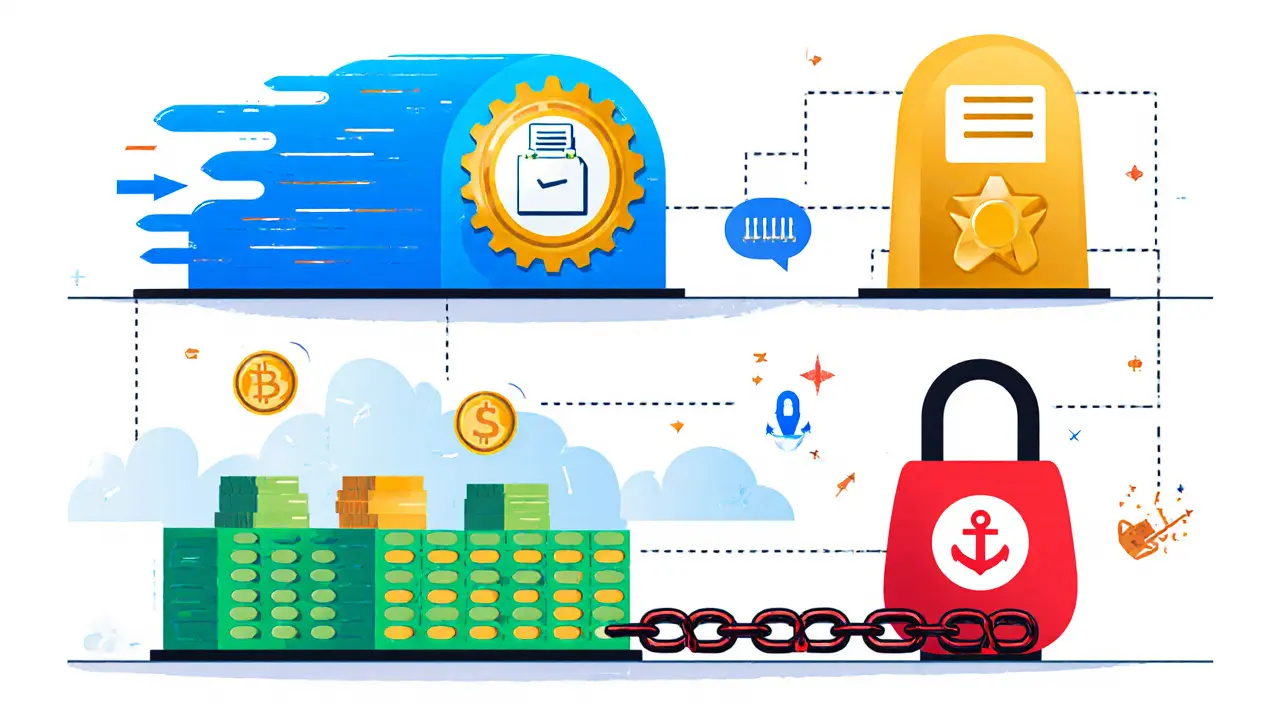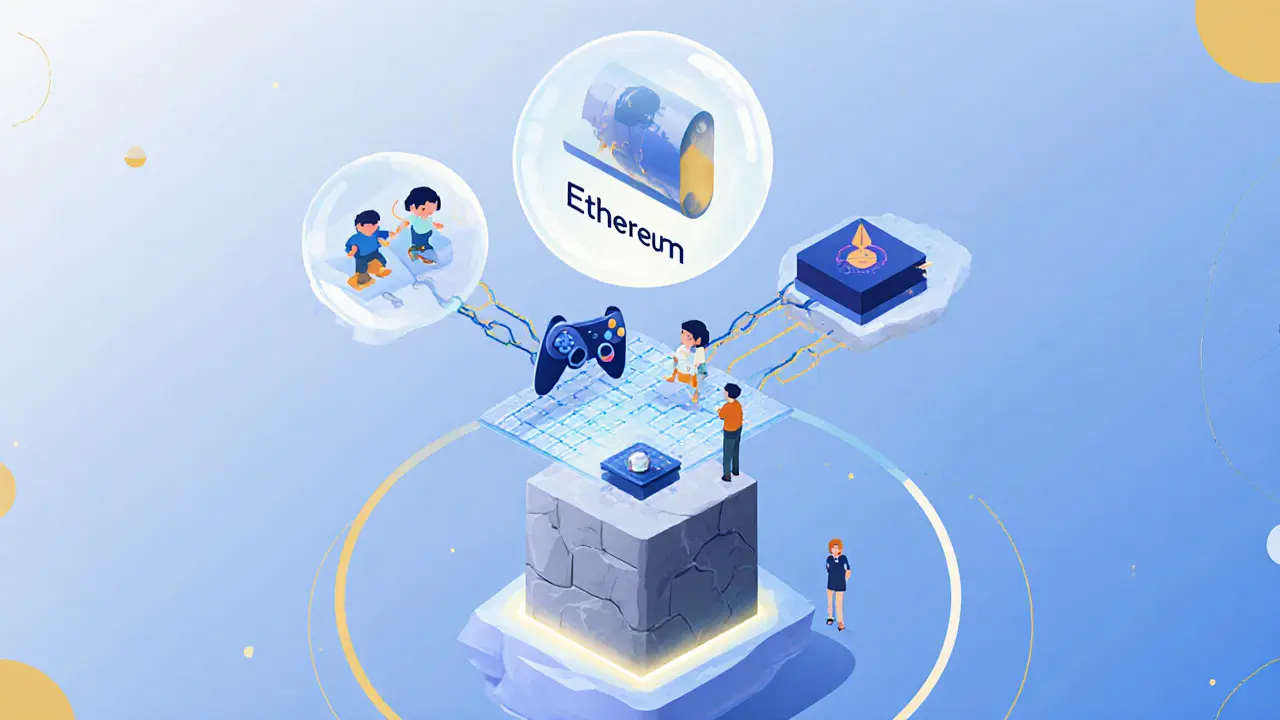
Modular Blockchain Cost Calculator
Calculate potential savings when switching from monolithic blockchains (like Ethereum mainnet) to modular architectures with rollups.
Blockchain networks have been stuck in a bottleneck for years. Every transaction has to be processed, verified, and stored by every single node. That’s why Ethereum felt slow and expensive during peak times. Why? Because it tried to do everything in one place - execution, consensus, data storage - all on the same chain. It worked when there were a few thousand users. But when millions started using DeFi, NFTs, and dApps, the system groaned. The solution isn’t making the chain bigger. It’s breaking it apart.
What Modular Blockchain Architecture Actually Means
Modular blockchain architecture isn’t just a buzzword. It’s a structural rewrite of how blockchains work. Instead of one giant chain doing all the work, modular systems split responsibilities into specialized layers. Think of it like a factory where one team handles assembly, another inspects quality, and a third manages inventory. Each team focuses on one thing and does it better. There are four core layers in a modular blockchain:- Execution Layer: Where transactions happen - smart contracts run, users swap tokens, NFTs are minted.
- Consensus Layer: Decides which transactions are valid and in what order. This is where proof-of-stake or other validation rules are enforced.
- Data Availability Layer: Stores transaction data securely so anyone can verify it later. This layer doesn’t process transactions - it just keeps them safe and accessible.
- Settlement Layer: Finalizes transactions and resolves disputes. Often acts as the anchor for security across other layers.
This separation means each layer can be optimized independently. The execution layer can be lightning-fast. The data layer can be cheap and highly redundant. The consensus layer can be energy-efficient. None of these improvements would be possible if everything was stuck together.
Why Monolithic Blockchains Are Falling Behind
Monolithic blockchains like Bitcoin and early Ethereum force every node to handle everything. That sounds secure - and it is - but it’s also incredibly inefficient. Every time you send a token or mint an NFT, every node on the network must download, verify, and store that data. That’s why gas fees spike during busy times. That’s why Ethereum couldn’t scale to support millions of users without major upgrades. The problem isn’t just speed. It’s cost. Storing data on every node eats up bandwidth and storage. For a blockchain to grow, it needs to offload data without sacrificing trust. Monolithic chains can’t do that. Modular chains can.Take Ethereum’s Dencun upgrade in early 2024. It didn’t change how transactions were processed. Instead, it introduced proto-danksharding, which created a dedicated space for rollups to store their data off the main chain. That cut transaction costs by up to 90% for some users. That’s not a tweak - it’s a structural shift toward modularity.
Real-World Examples Leading the Charge
You don’t have to guess what modular blockchains look like in practice. Several platforms are already running them at scale.- Polkadot was built modular from day one. Its relay chain handles consensus and security, while its parachains run their own execution environments. The upcoming JAM architecture will let developers build custom chains with even more control over their execution layer - all while sharing Polkadot’s security.
- Celestia doesn’t execute transactions at all. It’s purely a data availability layer. Rollups like Arbitrum and Optimism use Celestia to store their transaction data cheaply and securely. Celestia proves you don’t need to be a full blockchain to be critical to the ecosystem.
- Dymension gives developers a ready-made consensus and settlement layer. You plug in your own execution environment - a custom smart contract chain - and Dymension handles the rest. These are called RollApps, and they’re already live with real users.
- Ethereum is transitioning from monolithic to modular. Its future isn’t one giant chain. It’s a settlement layer for hundreds of specialized rollups, each handling different types of apps - gaming, payments, identity - without crowding each other.
These aren’t experiments. They’re production systems handling billions in value. The shift isn’t coming. It’s already here.

Benefits You Can Actually Feel
Modular blockchains aren’t just technically smarter - they deliver real advantages to users and developers.- Lower fees: By offloading data and execution, transaction costs drop dramatically. On rollups using Celestia, users pay pennies instead of dollars.
- Faster speeds: Specialized execution layers can process thousands of transactions per second. Compare that to Ethereum’s old 15-30 TPS.
- More innovation: Developers aren’t stuck with Ethereum’s rules. They can build chains optimized for gaming, finance, or AI - with custom tokenomics, faster finality, or different virtual machines.
- Better security: A bug in one rollup doesn’t bring down the whole network. If a settlement layer like Ethereum gets compromised, it’s still harder to attack because data is stored across multiple sources.
Users on platforms like Arbitrum and zkSync report transaction speeds that feel like Web2 apps - instant confirmations, no waiting, no gas anxiety. That’s not a minor improvement. That’s a revolution in user experience.
What’s Holding Modular Blockchains Back?
It’s not all smooth sailing. Modular systems introduce new challenges.The biggest one? Complexity. For users, interacting with multiple layers can be confusing. Sending a token might involve a rollup, a data availability provider, and a settlement chain. Wallets and interfaces are catching up, but they’re not there yet. A beginner might not understand why their transaction is “pending on Celestia” - and that’s a usability problem.
Interoperability is another hurdle. If every rollup uses a different execution environment, how do they talk to each other? Projects like LayerZero and Wormhole are building bridges, but trustless, secure cross-chain communication is still an active area of research. A flaw in one bridge could drain funds across multiple chains.
And then there’s the developer learning curve. Building on a modular stack means understanding not just smart contracts, but consensus mechanisms, data availability proofs, and cross-chain messaging. Documentation varies wildly - Polkadot has excellent guides. Some newer chains have barely any.
These aren’t dealbreakers. They’re growing pains. The tools are improving fast. Wallets like MetaMask are adding rollup support. Frameworks like Foundry and Hardhat now have modular-specific plugins. The ecosystem is learning how to hide complexity from users while giving developers the power they need.

The Future: A Layered Ecosystem, Not One Chain to Rule Them All
The future of blockchain isn’t one dominant chain. It’s a layered ecosystem.Think of it like the internet. No single server runs everything. You have DNS servers, content delivery networks, cloud providers, email systems - each doing one thing well. Modular blockchains are moving toward the same model.
By 2026, we’ll likely see:
- Base layers like Ethereum or Polygon CDK acting as settlement anchors - secure, slow, and trusted.
- Execution rollups for specific use cases: one for DeFi, one for social media, one for supply chain tracking.
- Specialized data layers like Celestia or EigenDA handling storage for hundreds of rollups.
- Interoperability protocols that let assets and data move between chains without centralized bridges.
This isn’t fragmentation. It’s specialization. Just like you don’t use a single app for banking, messaging, and shopping, you won’t need one blockchain to do everything. You’ll use the right tool for the job.
Even monolithic chains aren’t disappearing. They’ll become the foundation - the backbone - that keeps everything secure. But the innovation, the speed, the low cost - that’s happening on the modular layers above them.
What This Means for You
If you’re a user: expect faster, cheaper transactions. Your next NFT mint or DeFi trade won’t cost $50 in gas. It’ll cost less than a coffee. Wallets will get smarter, hiding the complexity behind the scenes.If you’re a developer: you have more freedom than ever. Build a chain for your game, your marketplace, your AI agent - and plug it into a secure, scalable infrastructure without reinventing the wheel.
If you’re an investor: look beyond the hype. The real value isn’t in another meme coin. It’s in the infrastructure - the data layers, the rollup frameworks, the interoperability protocols. These are the plumbing of the next-generation internet.
Modular blockchain architecture isn’t just the future. It’s the only way blockchain scales without sacrificing decentralization. The old model is reaching its limit. The new one is already here - quiet, efficient, and quietly changing everything.
What’s the difference between modular and monolithic blockchains?
Monolithic blockchains handle execution, consensus, and data storage all on one chain - like a single computer doing everything. Modular blockchains split these tasks into separate layers, each optimized for its job. This lets modular chains process more transactions faster and cheaper, without needing every node to store everything.
Is Ethereum now a modular blockchain?
Yes, Ethereum is transitioning to a modular architecture. The Dencun upgrade in 2024 introduced proto-danksharding, which offloads transaction data to specialized data availability layers. Ethereum will remain the settlement layer, while rollups handle most execution. This makes Ethereum more scalable without compromising its security.
What role does Celestia play in modular blockchains?
Celestia is a dedicated data availability layer. It doesn’t execute transactions or run smart contracts. Instead, it securely stores transaction data for rollups like Arbitrum and zkSync. This lets those rollups focus on speed and low cost, while Celestia ensures the data is always available and verifiable.
Are modular blockchains more secure than monolithic ones?
They can be. By separating functions, a vulnerability in one layer (like a rollup) doesn’t compromise the entire system. Security is also strengthened because critical functions like data availability and settlement are handled by specialized, battle-tested layers like Ethereum or Polkadot. However, new risks emerge around cross-chain bridges and interoperability protocols, which must be carefully designed.
Will modular blockchains replace Bitcoin and Ethereum?
Not replace - evolve. Bitcoin will likely stay as a secure, simple store of value. Ethereum will become the settlement backbone for modular systems. New chains will emerge on top, handling specific tasks like gaming, payments, or AI. The future is a layered ecosystem, not a single winner.
How can I start using modular blockchains?
Start by using a wallet like MetaMask and connecting to a rollup like Arbitrum, Optimism, or zkSync. These are already live, user-friendly, and much cheaper than Ethereum mainnet. You don’t need to understand the layers - the interface hides them. Just send a transaction and notice how fast and cheap it is.
Hannah Kleyn
15 11 25 / 05:12 AMModular blockchains are just the internet repeating its own history
Remember when everyone thought one OS would rule everything? Then came Linux, macOS, Windows, Android, iOS
Same thing here
No single chain can do it all
Specialization wins
Simple as that
Why fight it
ratheesh chandran
15 11 25 / 17:26 PMso we're building a blockchain stack like we're building a house with 7 different contractors and no central foreman
what happens when one guy shows up late
what happens when the data layer says the execution layer lied
who pays for the mess
we're not solving problems we're just outsourcing them to other people's problems
and calling it innovation
lol
Kelly McSwiggan
17 11 25 / 01:58 AMcongrats you've reinvented client-server architecture but with 14 layers of crypto jargon and 3x the attack surface
the only thing modular here is the delusion
everyone's just pretending they're not building a glorified API gateway
and calling it decentralization
bravo
sandeep honey
17 11 25 / 19:46 PMwhat about cross chain liquidity fragmentation
if every rollup has its own token and liquidity pool
how do small devs compete
is this just another way for whales to control more chains
why is no one talking about this
Kandice Dondona
18 11 25 / 10:40 AMTHIS IS THE FUTURE 🚀
finally we're moving beyond the 'one chain to rule them all' fantasy
modular = freedom
lower fees = more people on board
you can build anything now
game devs
artists
scientists
all welcome 🌍✨
Vanshika Bahiya
20 11 25 / 10:34 AMif you're new to this
start with Arbitrum or zkSync
they're already live
MetaMask connects to them automatically
you don't need to understand the layers
just send a transaction
notice how fast and cheap it is
that's the magic
the tech is hiding in plain sight
and it's working
Drew Monrad
21 11 25 / 23:15 PMmodular blockchains are just a fancy way of saying 'we gave up on decentralization and built a distributed monolith'
now instead of one giant node
we have 7 different companies managing 7 different layers
who's auditing Celestia
who's controlling the settlement layer
who owns the bridges
it's all just centralized with extra steps
and more fees
gary buena
23 11 25 / 03:04 AMthe fact that we're having this conversation at all is kinda hilarious
we spent 10 years trying to make blockchains faster
and the answer was to stop pretending one chain can do everything
who knew
also i just used a rollup for the first time
gas was 0.002 eth
it felt like magic
and i didn't even know what layer i was on
that's the point
Anthony Forsythe
24 11 25 / 06:19 AMthink of it this way
the monolithic chain was a cathedral
massive
imposing
built to last
but only a few could enter
modular is the open market
stalls everywhere
vendors shouting
crowds flowing
chaos
but alive
and the cathedral? now it's just the town square
still there
still sacred
but no longer the only place that matters
Katherine Wagner
24 11 25 / 13:22 PMmodular blockchains are a scam
they're just layering fees
you pay for execution
you pay for data
you pay for settlement
you pay for bridging
and you still get hacked
the only thing modular here is the scam
and the people who sold you this
Becky Shea Cafouros
25 11 25 / 16:41 PMthe article is technically accurate
but it ignores the human cost
users don't care about layers
they care if their transaction works
if their wallet crashes
if their NFT disappears
adding complexity doesn't solve UX problems
it just hides them behind more menus
and more support tickets
Cherbey Gift
26 11 25 / 19:58 PMwe're not building blockchains
we're building a digital religion
with seven sacraments
and seven layers of holy data
and the priests? they're the devs who wrote the specs
and the congregation? they're the ones buying tokens hoping the magic doesn't vanish
the truth
is that we're all just praying to a machine
and calling it progress
anthony silva
26 11 25 / 20:02 PMlol
so now we need a blockchain to manage our blockchains
congrats
you just invented the internet
but with more gas fees
Byron Kelleher
28 11 25 / 09:06 AMhey everyone
i just want to say
this is actually kind of beautiful
we're not trying to control everything anymore
we're letting different tools do what they do best
and that's how real progress happens
not by forcing everything into one box
but by letting things breathe
and connect
it's not perfect
but it's honest
Mandy Hunt
29 11 25 / 12:53 PMwho owns the data availability layer
who controls the settlement chain
what if Celestia gets bought by a big tech company
what if Ethereum becomes a government-backed settlement layer
modular doesn't mean decentralized
it just means more points of control
and more targets
for surveillance
for censorship
for control
Cody Leach
29 11 25 / 18:50 PMthe real win here is that developers can finally build without begging Ethereum for permission
no more waiting for upgrades
no more gas wars
you want a chain for AI agents
build it
you want one for real estate tokens
build it
the infrastructure is there
the tools are getting better
the future is open
Albert Melkonian
30 11 25 / 06:11 AMIt is imperative to acknowledge that the paradigm shift toward modular blockchain architecture represents not merely a technical evolution but a fundamental reconfiguration of trust architecture in decentralized systems
The separation of concerns enables optimal resource allocation
and minimizes systemic risk through functional isolation
Moreover, the composability of specialized layers fosters unprecedented innovation velocity
While challenges related to interoperability and user experience remain nontrivial
the trajectory is unequivocally aligned with the principles of scalability, security, and sustainability
One must therefore approach this transition not with skepticism
but with rigorous intellectual engagement